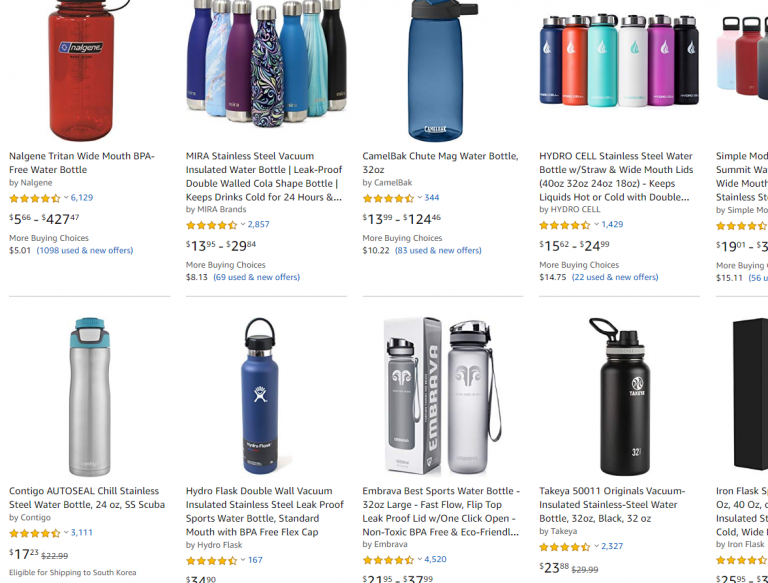Product description ideas commonly used by Big Amazon sellers

In the process of listing optimization after new products are put on Amazon’s shelves, product description is the second most important content next to the title, and it is also the main reason for customers to know about the products and feel relieved to purchase. The quality of product description will affect the conversion rate. How do some big sellers write their product descriptions?
Product description is one of the factors that make sellers successful on Amazon platform. The product descriptions of all successful sellers will not deliberately exaggerate product functionality or utility for the sake of sales.
This article will combine a few examples to illustrate what kind of listing copies are more popular with consumers, which copies have no practical effect, and which copies might get you a bad review:
Example 1: Description of a kettle
Unrecommended version: BESTSELLING WATER BOTTLE ON AMAZON! Awesome features make this the only water bottle you’ll ever need. Check out our reviews and see that this new water bottle beats all the others hands down!!
Recommended version: No-Dribble Mouthpiece Design: Unlike ordinary water bottles which aren’t constructed to fit your mouth, this [brand] bottle offers an ergonomically designed, no-dribble sipping spout for added comfort
We notice that in the first description, consumers can not get any details related to the kettle, only the seller’s enthusiasm. In the second description, simply one or two sentences can let consumers know what is unique about the kettle.
Product details are exactly what customers want to know when they buy a product, and you don’t want customers to turn to your competitors only because they can’t find any product details in your description, right?
To say the least, even if the customer buys your product, he will find it is not what he expected after he got it. He may return your product. What’s worse, a disappointed customer may leave a negative review, which is unfavorable for your subsequent sales.
Then, how do you avoid overstating in your product description?
1, it is recommended not to use the superlative form. When you describe a product as “the best”, “the most valuable”, or “the cutest”, you need to provide specific evidence, such as comments from third parties such as industry celebrities, web celebrities, or well-known customers. Otherwise, the customers will feel that you’re just bragging.
The relevant policy of Google Ad Words prohibits users from using the superlative form to promote their products or services. “In the absence of third-party recognition and support, users are prohibited from using superlative (‘ best ‘) and comparative (‘ better than ‘) descriptions in the promotion copy of landing page.
2. Reduce the use of exclamation marks. Many lazy sellers usually try to use exclamation marks to express their excitement, but for readers, it’s somewhat visual noise.
Don’t claim something impossible or false. For example, “you’ll shed pounds without playing or exercise”, “the blender that gives your vegetables four-star taste” and “a scent that no man can resist” and similar description. Some consumers will immediately recognize your exaggeration. Although some consumers may believe it, they will be disappointed when they get the product and you may suffer. When writing the product description, the seller should conform to the true situation of the product, and when describing the product effect, it is best to provide practical evidence.
4. Do not add too much emotional description. Most of the product description is given priority to the adjectives, except for words such as “minute”, “durable”, “soft”, and “contemporary” and similar words that help consumers understand features of the product, many sellers use meaningless exclamations such as “amazing”, “exciting”, and “fascinating”, but these words are useless for customers to understand your product.
At this point, some sellers will say that, the product description will appear very monotonous without these words and symbols, don’t worry.
Here are four ways to make your product descriptions alive:
1, Use sensory language. Sensory language here refers to visual, auditory, or tactile descriptive words. These words can stimulate the reader’s imagination, and of course it is better to add a touch of emotion. For example, you are selling plush toys. The seller might use “soft” or “cottony” to describe the soft texture. But you can try using “snuggly” instead. Does that make it more imaginative to snuggle with your doll, as if snuggling it was comforting?
As shown in the figure above, Patagonia shorts use words such as “comfortable against the skin” and “soft to the touch” instead of simply using “soft” or “comfortable” in the description to make customers feel comfortable even they have not got the product
2, Imaginative scenario. Describing product usage scenarios helps shoppers understand how to apply products in their lives. Assuming you’re selling an ergonomic stapler, you can tell the consumer that they will not feel tired even if they’re continuously stapling 100 copies of materials.

As shown above, Moose jaw describes their ladies’ hoodies as “a cozy wrap for cool coffee mornings or heading to yoga at the downtown studio”.
3, Use unexpected vocabularies. Moose jaw describes the length of the hoodie in the figure above as “tunic length to cover your legging-bottomed tush” instead of directly saying a few inches below the waist. When describing the thickness of the jacket, it says “long sleeve to keep the goosebumps at bay” instead of directly saying “long-sleeved to keep you warm”. Besides this hoodie, the descriptions of other winter products on Moose jaw.com are also very interesting, such as “ready to trap warm air next to your body”, “while it’s going to be useful you know,” and something like that.
4, Use the tone of communication. Try a conversation instead of a serious text format. You can use more informal languages such as “you” and “we” to convey your views in informal languages such as questions or short sentences. For instance, “You know how guests never know where to sit at dinner parties? Without kooky place cards, your shindig kicks off on a fun note”.
The sofa description of British e-commerce Loaf is like a talkative furniture salesman chatting with his customers, using “easy-peasy”, “No problem!” and “Call us to find out more” and other spoken expressions.

As shown above, King Arthur Flour also took a nickname “Zo” for their high-end toaster.

In this way, do you find that product descriptions can be as fresh as they are without exaggeration or exaggeration, and that they can provide your potential customers with the most authentic and reliable product information. You can try to write a product description copy step by step.
Summary:
- Recapitulative words or phrases make the description of the product clearer, and the following paragraphs can be used as supplements or explanations;
- Check the words to confirm if there are repeated words, and if it can be replaced with other words, too many keywords is not very friendly to the SEO of listing;
- Check spelling and grammar to avoid typos that seems very unprofessional;
- You can also retouch it a bit after finishing a description, adding sentences that can initiate consumers to purchase desires;
- Be concise and use the least vocabulary to express the meaning;
- You can imitate but do not copy, if you do not know how to write a description, you can refer to the other seller’s description, rewrite, but do not copy them all, this will not be helpful for your product to attract customers.
About Tool4seller
A best-in-class Amazon seller tool that is specialized in sales& profits analytics, PPC optimization, keyword research, competitor tracking, instant alerts for listing hijacking, price changing, and inventory updates, etc.



